The Bolivian Ram is definitely one of the most fascinating species of freshwater fish out there.
These aquarium fish have been a long-time favorite for those with a fishkeeping hobby due to their incredibly unique patterns and coloration, combined with their brilliant personalities, social skills, and their peaceful nature (except when breeding).
Originating from, you guessed it, Bolivia as well as Brazil (Amazon River), the Bolivian Ram goes by several names, with the scientific being “Mikrogeophagus Altispinosus”, and the other name given to this fish is the Bolivian Butterfly. Despite being a Ram by name, they are actually a part of the dwarf cichlids family.
Bolivian Ram Cichlid Summary and General Information
The Bolivian Ram is perhaps one of the most beautiful fish, not only of its kind, but out of all the freshwater fish you could choose to occupy your aquarium.
With stunning extended fin rays, and a gorgeous brightly colored body, it is certainly hard to argue this point.
The image below is a short overview of the bolivian ram cichlid, providing key information for your reference - feel free to download the image:
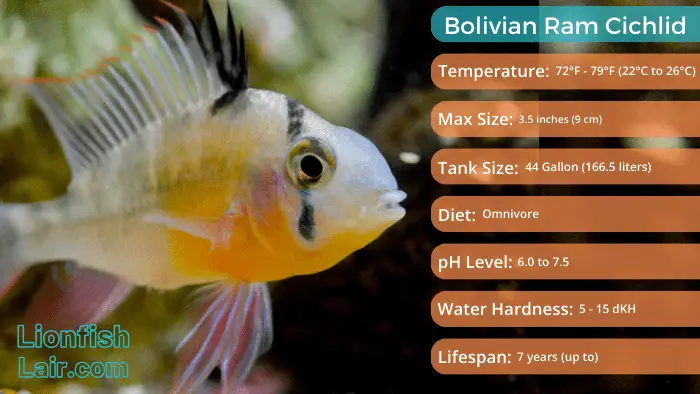
They are not only aesthetically pretty, but they have fantastic personalities, and will certainly strike up several friendships with the rest of the community they are in, making bonds with other tank mates, and also recognizing their owners.
Not to mention that they are incredibly easy to keep and are super hardy too! Here is a brief overview on the Bolivian Ram Cichlid:
- The tank size must be a minimum of 44 Gallons (166.5 Liters).
- Ideal group size is 6 to 8 (but you can get away with 4 or 10, however, not recommended).
- The water temperature for these fish must be 72°F to 79°F (22°C to 26°C).
- Your tanks pH level must be 6 to 7.5.
- The hardness is 5 to 15 dGH.
- Their lifespan is between 4 to 7 years depending on how well you look after them.
- When it comes to breeding, they scatter their eggs around the tank.
- The adults will grow to a maximum length of 3.5 inches (9 cm).
- Their preferred tank level is typically the middle or bottom – they tend to commandeer the area in-between.
They have a wide span in terms of their natural habitat. In the wild they encompass many areas of the Amazon River Basin in both Brazil and Bolivia.
These waters are both slow-moving and shallow. Plants and trees overhang into the rivers, and there is an abundance of plant life on the muddy bed which creates much shade – it would be recommended to attempt to somewhat recreate this environment in your tank.
Appearance and Genetics
As mentioned with great enthusiasm previously, the Bolivian Ram is an incredibly stunning fish, sporting a pale-yellow body, with bright orange colors encompassing its head and chest. Their pattern is pretty awesome too, with vertical gray stripes shimmering down their body, from the middle of their body to the base of their tail.
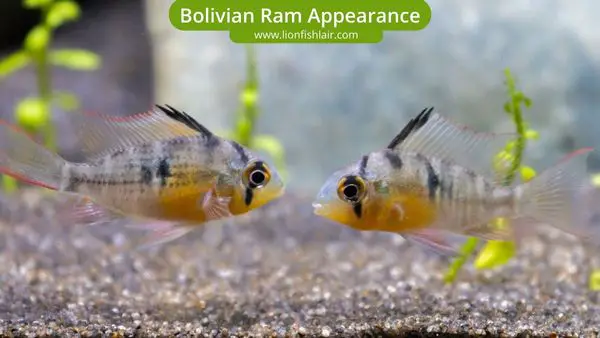
They have a vertical dark stripe that passes over their head and directly through the eye, resembling something of an awesome scar.
They also have large, beady eyes and a big black spot taking up a large percentage of the middle of their body.
Their fins are elongated rays that looks especially beautiful on this incredible fish, with each of their fins being transparent with a red edging.
The dorsal fin has a black stripe at the beginning, and the pelvic and anal fins are covered in light blue streaks, making for one of the most colorful freshwater fish you could acquire for your tank and aquarium.
How can you tell the sex of Bolivian Rams? You can also determine the sex of these fish with relative ease.
You can tell the sexual dimorphism between the male and female Bolivian Ram if you closely observe, with the females being slightly smaller than the males, and the males also possess longer dorsal fins than the females.
Size and Length
The Bolivian Rams are smaller than other cichlids – you can expect you Ram to grow to 3.5 inches in length, which is about 9 cm, this is, in a lot of hobbyist’s opinions, the perfect size for a fish for both beginners and experts.
Females tend to be a little smaller, growing to around 3 inches which is 7.5 cm.
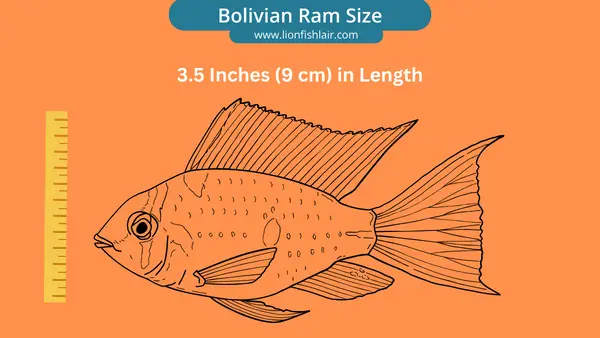
Lifespan
These fish have a typical lifespan of anywhere between 4 to 7 years, however the lifespan of a fish is almost certainly dependent on the water quality, environment, and cleanliness of the tank they reside in.
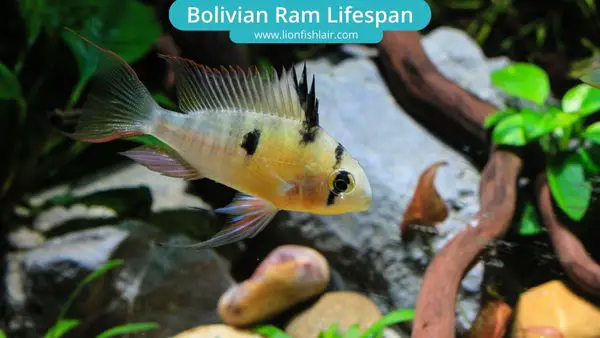
Behavior and Temperament
These fish are not only awesome to look at, but they are incredibly social and highly intelligent, spending the majority of their time swimming around in open spaces, socializing with others of their kind even other fish species.
They love hiding spaces along the bottom and middle of your tank, so make sure to provide plenty of awesome spots for them to hide and relax in. Also, they will swim around the bottom, kicking up the sandy substrate, looking for food.
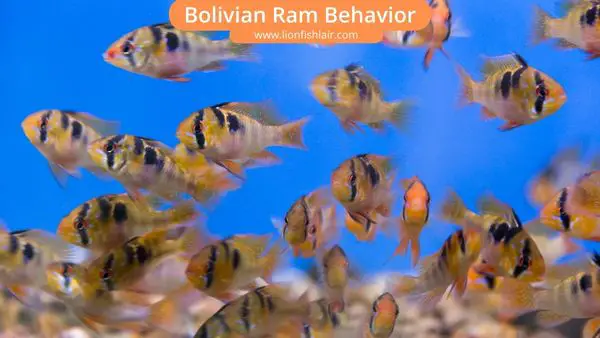
In terms of their temperament, they are non aggressive fish, especially with similarly peaceful freshwater fish.
However, they can become territorial if fish get too close to them during breeding times (understandably). Bolivian Rams have been known to fight eachother on occassion, so make sure you avoid this from happening.
The best way of achieving this is by lining the bottom of your tank with sandy substrate, and it is also great to mimic their river environment by adding the objects they are used to, giving them plenty of space and objects to explore.
Stones, caves, driftwood, and areas with live plants are fantastic additions. Here are some of the best plants to add; Java ferns, Vallisneria, Cryptocoryne, or Water wisteria. Adding shady areas to your tank is strongly recommended too.
Water Conditions and Tank Setup
Despite being tolerant to many different ranges of water conditions, the Bolivian Ram certainly needs attention to make sure their conditions are stable, which gives them the best possible quality of life.
Additionally, their tank setup is incredibly important to the health and happiness of these fish.
Tank Size
Bolivian rams can live in fish tanks as small as 30 gallons (113 liters). However, you will ideally want to keep a group of 4 residing in a 40 gallon (151 liters) or larger tank.
The bigger, the better when it comes to bolivian ram tanks as they enjoy their space and are incredibly active fish.
This graphic shows the most common dimensions for a 44 gallon bolivian ram tank:
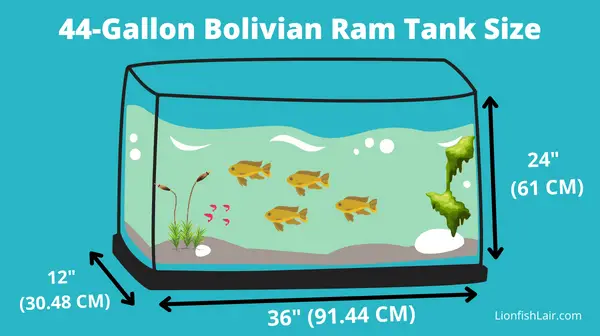
If you decide to have more than 4 bolivian rams, perhaps 8 or 10, then you will need an aquarium of at least 80 gallons (302 liters), and if you are keeping a bolivian ram alone, you could probably have a 25 gallon (95 liters) minimum, it can be difficult figuring out how many bolivian rams should be kept together, but the truth is, there is no right or wrong.
Water Parameters
Bolivian Rams can certainly handle many different water parameters and tank conditions, however, they will thrive in specific conditions suited to them. Here are the ideal water conditions:
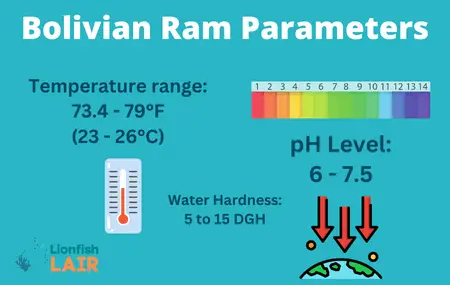
- Water temperature should be between 73.4°F to 79°F (23°C to 26°C).
- The waters pH level must be between 6 and 7.5 making it slightly acidic.
- The hardness of the water must be between 5 to 15 Dgh making it soft water.
- Once per week you should replace 20% to 25% of the water in the tank, removing any organic waste or uneaten food in the process.
Equipment and Decorations
Due to their natural waters being slow moving in the wild, installing a low water flow filter is important to do.
A recommendation would be to acquire an exterior-mounted canister filter, another recommendation would be to get a heater that will maintain the temperature of your water, keeping it as warm as their natural habitat.
You can either introduce shadowed areas to your tank, or perhaps just lower the lights in your tank.
The image below displays the perfect decor and environment to ensure your bolivian ram is happy and healthy:
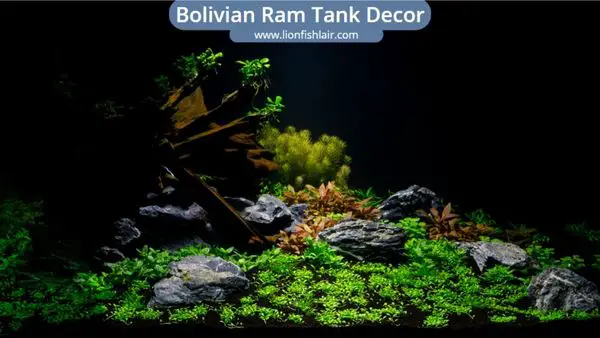
It is also recommended that you try and replicate their natural surroundings as well as you possibly can. Bolivian rams reside in dark waters in the Amazon, so, by heavily planting your tank and adding decor such as driftwood you will help achieve this.
Food and Diet
They will typically eat a wide range of different foods, which is great due to them not being fussy eaters.
They are omnivores so it is recommended to start things off by feeding them commercial flake or pellet-based foods.
They are not particularly big fish, but their mouths are even smaller in comparison to their bodies, so make sure to select the correct sized foods for their tiny mouths.
It is important to note that they will eat algae too, so, adding algae flakes or allowing them to feed off your aquarium algae will also benefit their diet.
The graphic below displays the different types of food you should be feeding your bolivian ram in order to achieve a balanced diet:

In order to make their diet as well-rounded as possible, it is good to add brine shrimp, tubifex, daphnia, or even a bloodworm to their meal, almost acting as a special treat!
These Bolivian Rams will typically feed from bacteria and organisms whilst sifting through your tank’s substrate, they are partial to a plant or two also.
The best habits are to feed these fish small amounts of food, several times per day so that they don’t overeat, and also so that there isn’t a large amount of leftover food as that will cause your tank to become dirty and potentially disease-ridden.
Tank Mates
The Bolivian Ram is not a schooling, nor a shoaling fish typically. However, they do tend to thrive within groups of 6 to 8 and will be absolutely fine living with different fish species of a similar peaceful temperament that share a similar size. Angelfish are a good option to accompany your bolivian ram.
The graphic below showcases four of the very best bolivian ram tank mates, but make sure you check out our detailed page dedicated to bolivian ram tank mates:
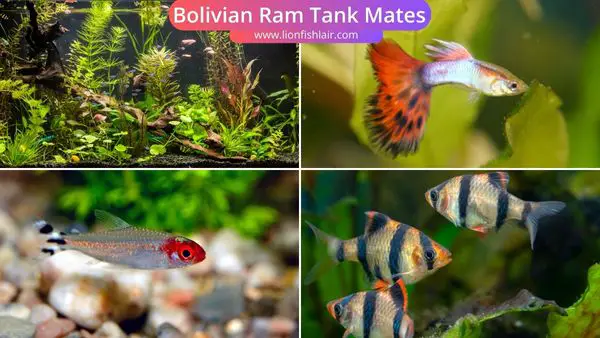
Tank mates are certainly appreciated by them, however, it is crucial that you acquire the right ones! Non-fish tank mates are also available for the bolivian ram. Something to keep in mind when finding Tank mates is that you find equally peaceful fish with similar personality traits.
Diseases and General Hardiness
Despite mentioning that they are certainly not disease-prone fish, and are very hardy fish, you will still have to look out for issues such as common tank ailments, an example being ich. Ich is a treatable and certainly a reversible illness and can be treated by sorting out tank conditions and adding medication to the water.
Medication can be purchased online or in store. However, the majority of these freshwater tank diseases can be avoided by making sure your tank is totally clean, and the water is being constantly replenished and maintained.
Bolivian Ram Breeding
Breeding Bolivian Rams is as straightforward as most other fish, they reach a reproductive age that is anywhere between 9 to 10 months old. At that stage they are around 1.5 inches long (4 cm).
It is hard at this age to decipher whether or not they are male or female as usually you can differentiate once they reach full size and maturity.
Setting up the Tank for Breeding
To avoid these Rams eggs or fry from being eaten it is highly recommended to prepare a separate tank specifically for the breeding process.
The tank should be at least 15 Gallons (68 Liters). Once you have prepared the tank, place a group of breeding fish in the mini freshwater aquarium to form their pairs.
It is important to make the fish feel as comfortable as possible, and this can be achieved by lining the bottom of the tank with substrate, flat stones, and small plants.
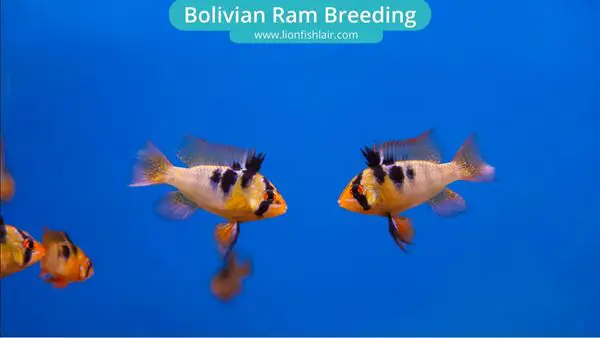
Raise the temperature to between 80°F and 82°F (27°C to 28°C) to stimulate the spawning process, while keeping the pH between 7 and 7.5, but increasing the water softness to 10 dGH.
The female will usually lay eggs from anywhere between 100 to 200 in less than an hour, then the male will fertilize them. Both the male and female will take care of the eggs, fanning them to keep water constantly moving above them and over them, removing any of the non-developing eggs.
The males will guard the eggs and prove fairly protective, such great parents!
After 2 to 4 days the eggs will hatch, and the larvae will eat their egg sacs for around a week, then they will start to swim and thrive. It is recommended to feed the young small and baby brine shrimp, vinegar eels, or nauplii.
It is a good option to keep the youngsters in the breeding tank until they are 2 to 3 months old, and big enough and experienced enough to join your community in the large tank.
Final Thoughts on Bolivian Ram Cichlid Care
To conclude, Bolivian Rams are probably one of the best freshwater fish to add to your tropical aquarium, or they could even be the first fish you purchase for your future freshwater community – the possibilities are truly endless!
Their price is fair, at roughly $5 per fish, however, they love being kept in groups, so stick to the recommended amount.
Making sure you are correctly maintaining your tank is imperative, That means constantly cleaning the inside, replenishing the water, and not overfeeding!
If these steps are followed you will certainly have these majestic little fish living happily and healthily within your community aquarium for many years.
